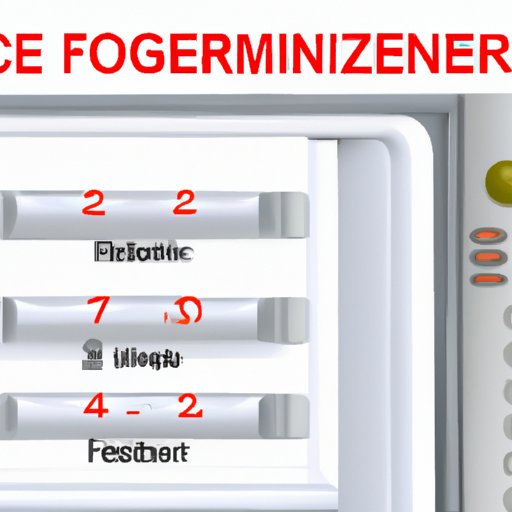Introduction
Keeping your refrigerator and freezer at the right temperature is essential for food safety and energy efficiency. But what is the optimal temperature range for refrigerator and freezer compartments? And why is it important to set and maintain the right temperature in your fridge and freezer? In this article, we’ll explore the ideal temperature settings for refrigerator and freezer compartments, how to set and maintain the proper temperature in your fridge and freezer, and tips for keeping your food safe.

Exploring the Optimal Temperature Settings for Refrigerator and Freezer Compartments
When it comes to the optimal temperature settings for refrigerator and freezer compartments, the United States Department of Agriculture (USDA) recommends that you keep your refrigerator temperature between 35 and 38 degrees Fahrenheit (1.7 and 3.3 degrees Celsius), and your freezer temperature between 0 and 5 degrees Fahrenheit (-17.8 and -15 degrees Celsius). This temperature range helps ensure that food stays fresh and safe to eat.
It’s important to note that these temperatures are only guidelines; some newer refrigerators may have slightly different temperature ranges. To be sure you’re getting the most accurate readings, check the manufacturer’s instructions or look up your specific model online.

How to Set and Maintain the Proper Temperature in Your Fridge and Freezer
Your refrigerator and freezer should have a temperature control dial or digital display to help you adjust the temperature. If you’re having trouble finding it, consult the owner’s manual or look up your specific model online. Once you’ve located the temperature control, you can use it to set the desired temperature range.
To maintain the proper temperature in your refrigerator and freezer, it’s important to regularly check the temperature using an appliance thermometer. Place the thermometer in the warmest part of the refrigerator and the coldest part of the freezer and leave it for 24 hours. Check the temperature after 24 hours and make any necessary adjustments.
Is Your Refrigerator and Freezer Temperature Too High or Too Low?
If the temperature in your refrigerator and freezer is too high or too low, there could be several factors at play. For example, if the doors of your refrigerator and freezer are left open for too long, this can cause the temperature to rise. Additionally, if the door seals are not airtight, this can also lead to higher temperatures. On the other hand, if the temperature inside your refrigerator and freezer is too low, this could be caused by a malfunctioning compressor or a dirty condenser coil.
If you suspect that the temperature in your refrigerator and freezer is too high or too low, it’s best to troubleshoot the problem as soon as possible. First, check the temperature control to make sure it’s set to the correct temperature. Then, inspect the door seals to make sure they’re airtight. Finally, check the condenser coils and compressor to make sure they are clean and functioning properly.
Keeping Your Food Safe: The Correct Temperature for Refrigerator and Freezer
Maintaining the correct temperature in your refrigerator and freezer is essential for keeping your food safe. When foods are stored at the wrong temperature, bacteria can grow quickly, leading to foodborne illnesses. To prevent this from happening, it’s important to set and maintain the right temperature in both compartments.
In addition to keeping your food safe, maintaining the correct temperature in your refrigerator and freezer can also help you save energy. When the temperature is too high, the unit will be working harder to keep the food cool, resulting in higher energy costs. Conversely, when the temperature is too low, the unit will be running unnecessarily, which can also increase your energy bills.
Here are some tips for setting the right temperature in your refrigerator and freezer:
- Check the temperature regularly using an appliance thermometer.
- Make sure the door seals are airtight.
- Clean the condenser coils and compressor regularly.
- Keep the refrigerator and freezer away from heat sources such as ovens, stoves, and radiators.
- Adjust the temperature control as needed.
Conclusion
Setting and maintaining the right temperature in your refrigerator and freezer is essential for food safety and energy efficiency. To ensure that your food stays fresh and safe to eat, it’s important to keep the temperature in both compartments within the recommended range. Additionally, it’s important to regularly check the temperature and make any necessary adjustments. By following these tips, you can rest assured that your food will stay safe and your energy bills will stay low.


